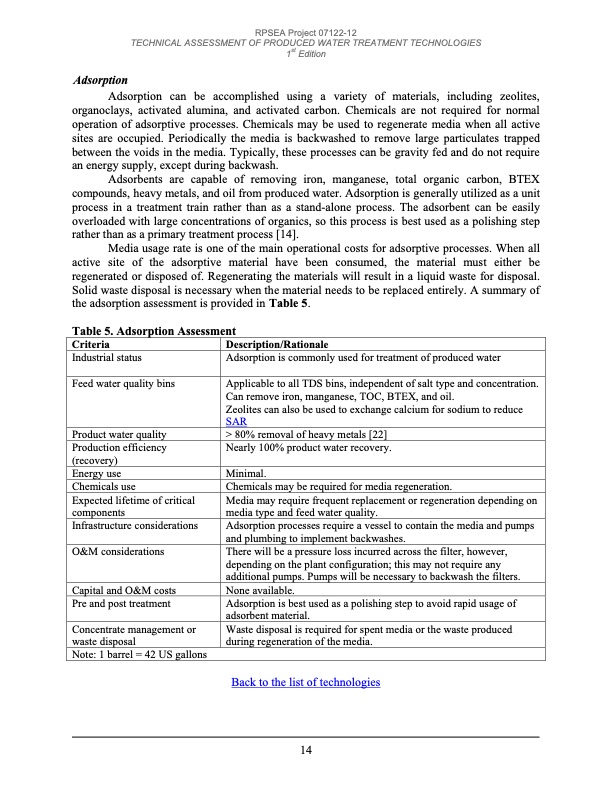
PDF Publication Title:
Text from PDF Page: 015
RPSEA Project 07122-12 TECHNICAL ASSESSMENT OF PRODUCED WATER TREATMENT TECHNOLOGIES 1st Edition Adsorption Adsorption can be accomplished using a variety of materials, including zeolites, organoclays, activated alumina, and activated carbon. Chemicals are not required for normal operation of adsorptive processes. Chemicals may be used to regenerate media when all active sites are occupied. Periodically the media is backwashed to remove large particulates trapped between the voids in the media. Typically, these processes can be gravity fed and do not require an energy supply, except during backwash. Adsorbents are capable of removing iron, manganese, total organic carbon, BTEX compounds, heavy metals, and oil from produced water. Adsorption is generally utilized as a unit process in a treatment train rather than as a stand-alone process. The adsorbent can be easily overloaded with large concentrations of organics, so this process is best used as a polishing step rather than as a primary treatment process [14]. Media usage rate is one of the main operational costs for adsorptive processes. When all active site of the adsorptive material have been consumed, the material must either be regenerated or disposed of. Regenerating the materials will result in a liquid waste for disposal. Solid waste disposal is necessary when the material needs to be replaced entirely. A summary of the adsorption assessment is provided in Table 5. Table 5. Adsorption Assessment Criteria Industrial status Product water quality Production efficiency (recovery) Energy use Chemicals use Expected lifetime of critical components Infrastructure considerations O&M considerations Capital and O&M costs Pre and post treatment Concentrate management or waste disposal Note: 1 barrel = 42 US gallons Description/Rationale Adsorption is commonly used for treatment of produced water > 80% removal of heavy metals [22] Nearly 100% product water recovery. Minimal. Chemicals may be required for media regeneration. Media may require frequent replacement or regeneration depending on media type and feed water quality. Adsorption processes require a vessel to contain the media and pumps and plumbing to implement backwashes. There will be a pressure loss incurred across the filter, however, depending on the plant configuration; this may not require any additional pumps. Pumps will be necessary to backwash the filters. None available. Adsorption is best used as a polishing step to avoid rapid usage of adsorbent material. Waste disposal is required for spent media or the waste produced during regeneration of the media. Back to the list of technologies Feed water quality bins Applicable to all TDS bins, independent of salt type and concentration. Can remove iron, manganese, TOC, BTEX, and oil. Zeolites can also be used to exchange calcium for sodium to reduce SAR 14PDF Image | TECHNICAL ASSESSMENT OF PRODUCED WATER TREATMENT TECHNOLOGIES

PDF Search Title:
TECHNICAL ASSESSMENT OF PRODUCED WATER TREATMENT TECHNOLOGIESOriginal File Name Searched:
Tech_Assessment_PW_Treatment_Tech.pdfDIY PDF Search: Google It | Yahoo | Bing
NFT (Non Fungible Token): Buy our tech, design, development or system NFT and become part of our tech NFT network... More Info
IT XR Project Redstone NFT Available for Sale: NFT for high tech turbine design with one part 3D printed counter-rotating energy turbine. Be part of the future with this NFT. Can be bought and sold but only one design NFT exists. Royalties go to the developer (Infinity) to keep enhancing design and applications... More Info
Infinity Turbine IT XR Project Redstone Design: NFT for sale... NFT for high tech turbine design with one part 3D printed counter-rotating energy turbine. Includes all rights to this turbine design, including license for Fluid Handling Block I and II for the turbine assembly and housing. The NFT includes the blueprints (cad/cam), revenue streams, and all future development of the IT XR Project Redstone... More Info
Infinity Turbine ROT Radial Outflow Turbine 24 Design and Worldwide Rights: NFT for sale... NFT for the ROT 24 energy turbine. Be part of the future with this NFT. This design can be bought and sold but only one design NFT exists. You may manufacture the unit, or get the revenues from its sale from Infinity Turbine. Royalties go to the developer (Infinity) to keep enhancing design and applications... More Info
Infinity Supercritical CO2 10 Liter Extractor Design and Worldwide Rights: The Infinity Supercritical 10L CO2 extractor is for botanical oil extraction, which is rich in terpenes and can produce shelf ready full spectrum oil. With over 5 years of development, this industry leader mature extractor machine has been sold since 2015 and is part of many profitable businesses. The process can also be used for electrowinning, e-waste recycling, and lithium battery recycling, gold mining electronic wastes, precious metals. CO2 can also be used in a reverse fuel cell with nafion to make a gas-to-liquids fuel, such as methanol, ethanol and butanol or ethylene. Supercritical CO2 has also been used for treating nafion to make it more effective catalyst. This NFT is for the purchase of worldwide rights which includes the design. More Info
NFT (Non Fungible Token): Buy our tech, design, development or system NFT and become part of our tech NFT network... More Info
Infinity Turbine Products: Special for this month, any plans are $10,000 for complete Cad/Cam blueprints. License is for one build. Try before you buy a production license. May pay by Bitcoin or other Crypto. Products Page... More Info
| CONTACT TEL: 608-238-6001 Email: greg@infinityturbine.com | RSS | AMP |